Appreciating Buddhist Art: Part Three – Bodhisattvas
PRIMITIVE - Friday, December 04, 2015By Misaki Imagawa
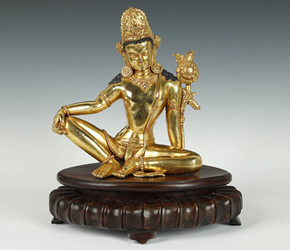 |
|
Perhaps the most common mistake regarding artistic depictions of Buddha is mistaking the historical Buddha (Siddhartha Gautama) and the Laughing Buddha, also known as Budai or the Fat Buddha. Depictions of Budai show him with long lobes, a broad smile and a big belly. There are many questions online asking, “When did Buddha become fat?” Sometimes they go hand in hand with questions like, “When did he sprout multiple heads and arms?” The answer is – he didn’t. The historical Buddha was a regular man with one head and two arms. Depictions of him vary depending on the country and time period, but he is almost always slender with a serene expression. So who is the popular potbellied laughing Buddha; and who are the Buddha-like figures who sit in meditative positions with celestial embellishments? They are bodhisattvas.
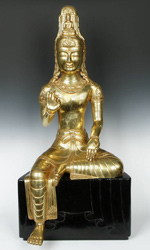 |
|
|
|
Bodhisattva is a term that has three meanings. The first meaning refers to a person who is on the way to enlightenment. Gautama Buddha was said to have referred to his pre-enlightened self as a bodhisattva. For example, in the Theravada sect of Buddhism (which scholars agree adheres to the earliest texts of Buddha’s teachings) the only bodhisattva is believed to be Maitreya, the next supreme Buddha after the teachings of Gautama have been forgotten and lost. The main point of the first meaning of boddhisattva is that it refers to individuals on their way to enlightenment.
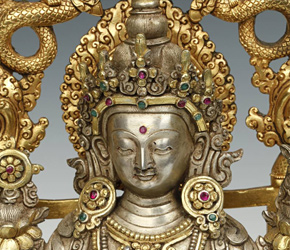 |
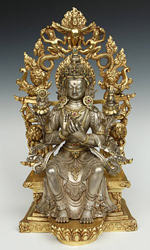 |
|
The second meaning of bodhisattva can be found in Mahayana Buddhism, where bodhisattvas are considered beings that are committed to the attainment of enlightenment for the sake of others. In other words, this is a reference to enlightened individuals who devote their time to helping others out of compassion, and to help eradicate the suffering of all living entities.
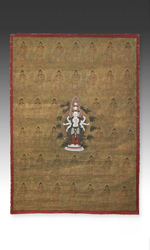 |
|
The third meaning of bodhisattva centers on archetypes, mythical beings who can be worshiped for different reasons. The most well known and worshiped archetypal bodhisattva is Avalokiteshvara, who is the embodiment of compassion. Depending on the culture and country, Avalokiteshvara is portrayed and described as male, female or even genderless. Not only depictions, but names may vary too. In China, she is called Quan Yin, meaning ‘one who listens to the cries of the world.’ In Japan she is known as Kannon Bosatsu; in Thailand and Cambodia, she is known as Lokeshvara, and so on.
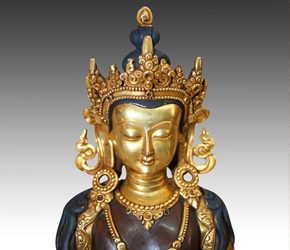 |
|
The stories behind how archetypal bodhisattvas came to be depicted can also vary widely. For example, it is said Avolokiteshvara was born from a single tear shed by Buddha. She vowed never to rest until the world was saved from samsara, the endless cycle of birth and rebirth; but when she understood all the woes of the people her head split into eleven pieces. Seeing this, Amitabha – one of the five celestial Buddhas – gave Quan Yin eleven heads. Then when she tried to reach out to all those who needed her help, her arms split into a thousand pieces. The Amitabha again came to her and this time gave her a thousand arms. Therefore, some East Asian depictions of Avalokiteshvara have multiple heads and arms, like the Thousand-Armed Avalokiteshvara.
Another popular bodhisattva is Manjusri, who embodies transcendent wisdom and is considered a meditation deity. As the first bodhisattva named in Mahayana scriptures, he is considered one of the oldest and most important. Often depicted with a sword and sutra in his hands, he represents great knowledge and the ability to cut through ignorance and delusions. Sometimes he is seen riding a blue lion, drawing the parallel between using wisdom to tame the mind and taming a wild ferocious beast. Although he appears fierce, Manjusri translates to ‘gentle glory’ or ‘sweet splendor’ and is also an auspicious figure for many believers. If you’re looking to pass an upcoming exam or muddling through a sticky life crisis, Manjusri would be the bodhisattva to turn to.
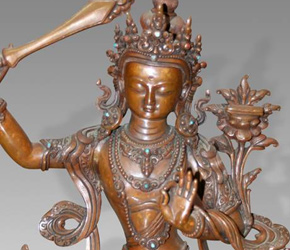 |
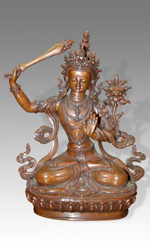 |
|
A third major bodhisattva is Maitreya, who we touched on earlier. Maitreya is believed by all sects of Buddhism to be the future Buddha, waiting in Tusita Heaven – the realm of divine beings – until it is time for him to succeed Gautama Buddha. Even though the Laughing Buddha or Budai, is widely seen as an incarnation of Maitreya; he was in fact a Chinese Zen monk who lived in the 10th century. His obese belly is rubbed for good luck and prosperity. Depictions show him wearing or carrying prayer beads and holding a sack of goods that never empties. In sculptural form, his belly is rubbed to bring prosperity and good luck. According to folklore, he was a selfless, giving man, who offered food to the hungry and happiness to the forlorn; but the main point is that he is a bodhisattva and not a Buddha, despite his name.
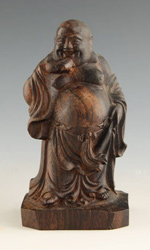 |
|
There ’s a story about Budai visiting a village giving out sweets and food to hungry children. One of the villagers approached him and asked, ‘what is the significance of Zen?’ To which he answered by simply smiling, dropping his sack and saying nothing. The next question he received was, ‘What is the actualization of Zen?’ Now, Budai wordlessly picked up his sack and continued giving away his goods to the people. By doing this, he was illustrating that Zen is about letting go of all worldly burdens and being free from suffering; but in order to achieve Zen, one must pick up the burdens of others and save them from suffering. This is the essence of the second meaning of bodhisattva.
In a sense, Budai ’s story of Zen and selflessness is reflected in all the bodhisattvas. Whether it is Avalokiteshvara, Manjusri, Maitreya or the many other bodhisattvas in the Buddhist pantheon, they manifest and are the embodiment of the original Buddha’s teachings. The sense of calm, compassion and clarity are a common denominator among Buddhist artworks depicting bodhisattvas. In the end, the most important thing after identifying a Buddha or bodhisattva image is a feeling of connection. It may, in fact, be the first and only thing. Like my mother used to say, “Buddha has many faces, and you will know when one speaks to you because you will feel it.” The same is true for bodhisattvas!
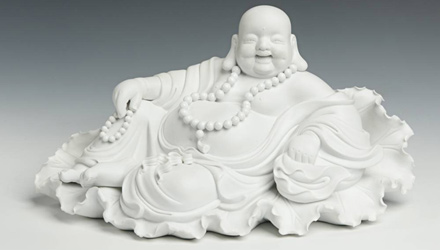 |
Download this Article: Appreciating Buddhist Art Part Three - Bodhisattvas.pdf